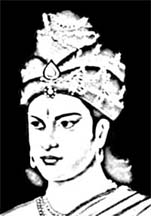STABLE GOVERNMENT (Central Leaders/ Emperors/ Recruits of
Merits)
|
The Mauryan Empire was established under the leadership
of Chandragupta Maurya who reigned from 322 BC - 296 BC. Under Chandragupta Maurya, all of northern India was united which
paved a path for trade and for expansion of the empire. By uniting, northern trade rapidly spread throughout the dynasty. He also
regulated agriculture and standardized weights and measurements . This new system of standardization
caused the first need for and appearance of money. Through the use of money
many problems were addressed by state leaders. It was pointed out
that taxation, sanitation and famine relief would cause problems in the empire.
|

|
|
NO PICTURE
AVAILABLE
FOR BINDUSARA
|
When the reign of Chandragupta
Maurya came to an end the tradition of the
transition of power from father to eldest son was enforced and his son and
successor, Bindusara (296 BC - 273 BC) became Emperor.
Some of Bindusara's accomplishments were the extension
of the Mauryan empire further south down to Mysore.
|
|
After Bindusara's
reign, his youngest son Asoka (273 BC - 232 BC) surprisingly took the throne
due to the assassination of Asoka's brothers. The act of having his own
brothers assassinated to receive the throne of the Mauryan empire interrupted
the cycle of leadership and power being passed from father to eldest son.
During his reign he began to pave a path of patronizing Buddhist teachings
throughout the empire.
|

|
The Mauryan Dynasty was said to only last approximately 200
years due to the lack of actively recruiting officials along with the
weak leadership of its emperors. This led the empire to turn from their
Confucius ways of running government and accept some legalists techniques
and concepts.
|

